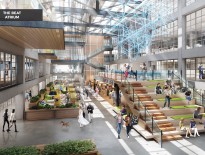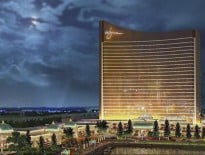
Library properties in Chicago were redeveloped with mixed-income multifamily buildings in a 2017 design competition. Now, Boston is seeking proposals to add housing at more than 80 municipal properties under a pilot program sponsored by the mayor’s Housing Innovation Lab.
Hundreds of municipal properties in Boston could be redeveloped with multifamily housing in a pilot program that could provide the added benefit of shielding firefighters from cancer-causing work environments.
The city’s latest strategy to generate more housing asks developers and architects to get creative about ways to add housing and mixed-use projects to active municipal buildings, said Marcy Ostberg, director of the mayor’s Housing Innovation Lab.
“We already know how to do dispositions,” Ostberg said. “This is mostly going to work with buildings that are in need of redevelopment. If it’s an aging library, then we’d consider (redeveloping) it with housing on the same site or next to it.”
A request for information issued this month lists 83 properties including library branches, parking garages and community centers that could be suitable for co-development as housing or mixed-use developments. Fire department properties figure prominently on the list of potential sites, which includes 32 firehouses and the Boston Fire Department’s headquarters on Southampton Street.
The city could leverage private investment to retrofit fire stations to reduce levels of carcinogenic fumes, installing new systems that isolate them from living and work areas, the RFI states.
Another 35 properties identified as secondary assets, primarily parking lots, could be used as development sites, Ostberg said. Such projects would generally require land swaps with nearby municipal buildings and require replacement of the municipal buildings.
The initial list of properties is just a start, Ostberg said, encompassing properties that provide basic services. But hundreds of properties eventually could become candidates for redevelopment.
The RFI seeks ideas that will simultaneously update aging municipal buildings in need of maintenance, and have capacity for additional development. It’s another strategy for multifamily housing generation, reflecting the city’s Boston 2030 master plan which set a goal of developing 53,000 additional residential units through 2030.
Expansion and renovation of aging buildings requires structural analysis of potential future uses, but offers significant potential, said David Bois, a principal at Boston-based architects Arrowstreet.
“If you can repurpose the existing lower levels and build on top of those, you get the best of both worlds,” Bois said. “You can keep the historic character but also the modern, contemporary construction. There are a number of unknowns when you start a renovation project and some of those drive up costs, but also drive the potential for some interesting and unique design opportunities.”
Maximizing Asset Disposition Strategies
Responses are due March 23. The co-development program takes a cue from pilot programs in several cities, including Chicago. Architects Skidmore, Owings & Merrill and NIA Architects were selected in a design competition to build a new library branch and two mixed-income multifamily buildings with street-level retail and community spaces in the city’s Near West Side.
Similar to asset dispositions by Massachusetts state agencies, the RFI also offers potential to preserve architecturally significant buildings, said Jay Wickersham, a partner at Noble, Wickersham & Heart LLP and president of the Boston Society of Architects. In Roslindale Village, a long-vacant MBTA substation has been redeveloped by Historic Boston, Roslindale Village Main Street and Peregrine Group LLC into 43 residential units and temporary host to a Trillium Brewing beer garden that opened in December.
“These projects can be more complicated, but they also can be a great win-win, because these government buildings tend to be prominently located,” Wickersham said.




 |
| 




